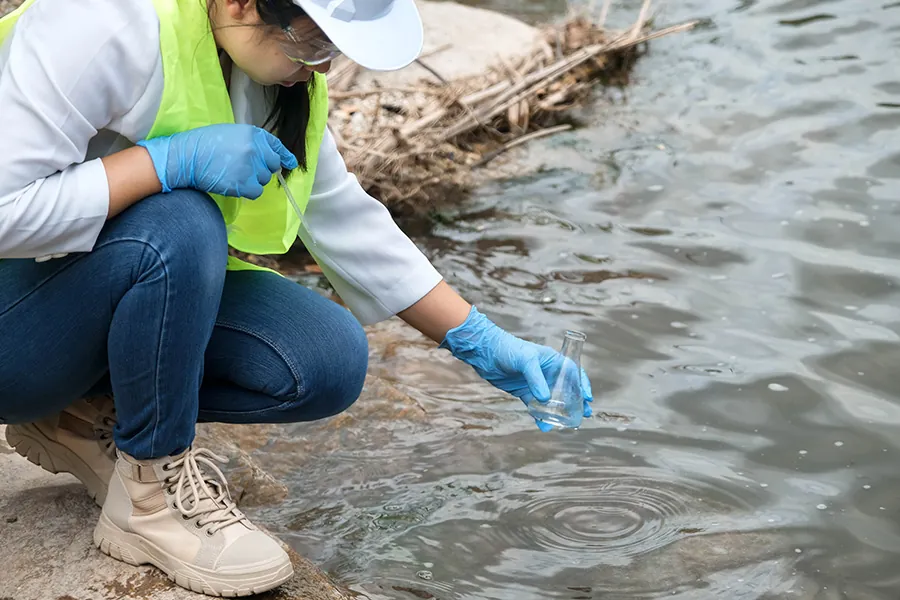Raleigh, NC: (919) 277-9299

Toxic tort litigation helps those who have been injured from exposure to harmful chemicals or compounds in water, soil, or air. Do you or a loved one need help with a toxic tort claim? Our attorneys pursue lawsuits for those harmed by occupational, environmental, pharmaceutical, and medical exposures.
Toxic tort laws govern civil legal actions involving injuries stemming from a contaminated environment or hazardous consumer goods. A toxic tort is a personal injury claim that can be brought against a company or individual for someone’s exposure to a harmful substance. If the responsible party fails to take accountability for subjecting individuals to toxins, those impacted may pursue legal action. A individual filing any type of toxic tort claim must prove general causation, which is the link between the harmful substance and the injury, and specific causation, which ties the exposure level and duration to the injury or illness the person experienced.
Let’s look at the types of toxic torts and how these lawsuits work.
Environmental Contamination
Producers of hazardous environmental pollutants may be held liable for causing an individual’s physical injury or disease. This may include corporations that pollute water sources, soil, or the air. This litigation may involve both toxic tort law, which addresses the civil wrongs, and environmental law, which protects human health.
These are examples of actions that might lead to toxic tort litigation:
- Improper waste disposal
- Chemical spills
- Emissions and pollution
Environmental contamination can affect individuals, families, and communities. Liable parties may include corporations, manufacturers, government agencies, or any entity found to neglect their public safety duties.
Contaminated Consumer Goods
When manufacturers, retailers, or distributors fail to disclose toxic components in household goods and someone is injured, one or more of these entities may be held responsible. These cases can be governed by product liability laws, which are legal principles that hold parties in the distribution chain responsible for producing or selling unreasonably dangerous goods.
Medical-Related Toxic Torts
When medical products contain dangerous substances or contaminants and patients are harmed, they may be able to pursue legal action through toxic tort lawsuits. These claims usually focus on two areas:
- Pharmaceuticals: Harmful effects from medications that were inadequately tested, produced with defects, or lacked proper warnings
- Medical Devices: Injuries caused by faulty medical devices
Premises Exposure
The presence of dangerous or contaminated materials—for example, asbestos, lead, silica, or mold—in homes or buildings can result in the development of exposure-related illnesses, and affected individuals may have grounds to take legal action.
Occupational Exposure
Workplace toxic tort claims entail lawsuits brought by employees for injuries or illnesses resulting from exposure to dangerous substances while on the job. Occupational hazards can include asbestos, silica, industrial chemicals, toxic mold, pesticides, and other dangerous substances.
Most often, third parties, for example the substance manufacturer, vendor, or the property owner of the business, are those named in claims for workplace exposures.
Elements of Toxic Torts
Every lawsuit for an exposure-related injury must establish certain facts to help support the claim. This is where toxic tort attorneys come in. We’ll gather evidence, studies, test results, and other documentation to support each element of your claim. Whether you experienced an injury or illness from an environmental pollutant or a household good, your claim must demonstrate the following:
1. Dangerous Substance
A substance must be proven inherently dangerous or harmful and capable of causing the alleged injury or illness. Establishing the substance’s hazardous nature requires toxicology studies and research by accredited agencies.
2. Exposure
Toxic torts also require proving that a person was exposed to the harmful substance and that their level of exposure was capable of activating the disease or illness. Exposure incidents that occurred years earlier or illnesses with long latency periods can complicate these claims, but that doesn’t always mean the claim can’t be pursued. An attorney can help investigate and gather human health risk assessments, expert evaluations, medical tests, and personal records to establish the exposure level and duration, even if it occurred years ago.
3. Injury, Illness, or Harm
A person who files a toxic tort must prove that they have contracted an illness or experienced an injury related to the claim. Medical records and physician testimony are primary evidence an attorney can use to demonstrate your harm.
4. Causation
Proving causation requires tying all the facts of your exposure and contracted illness or injury together using scientific facts, medical evidence, and expert testimony. Causation tells the entire story, presenting the substance’s hazardous nature, the level and duration of your exposure, and your resulting injury.
Next Steps: Recovering From Toxic Exposure
Knowing what to do after experiencing an injury due to a toxin can be difficult. Here are a few steps to get you started:
- Secure your safety: Stop using the product and discontinue contact with the contaminated environment, if possible.
- Seek medical care: This prioritizes your health and establishes an official diagnosis.
- Report the incident: Inform your employer, landlord, or the company to help prevent ongoing health risks.
- Create a timeline of exposure events: Document when the exposure began, your contact frequency, and other details.
- Preserve items: Retain any item, packaging, instructions, or receipts related to the substance
- Collect records: Obtain employment incident reports, environmental test results, and documentation of any chemical spills or similar incidents
- Speak with a lawyer: Discuss your experience to understand your legal options and the best path for moving forward
Toxic torts are complex lawsuits—let our attorneys help. We’ll evaluate your situation and work on the details, letting you focus on healing. If you or a loved one has been harmed by a hazardous substance, product, or environment, please share your story with us.
